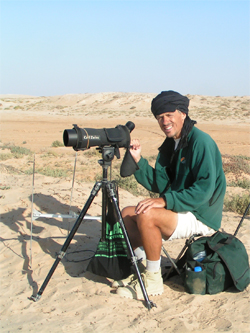Struggle for safety. Adaptive responses of wintering waders to their avian predators

Promotie: dhr. P.J. van den Hout, 13.15 uur, Academiegebouw, Broerstraat 5, Groningen
Proefschrift: Struggle for safety. Adaptive responses of wintering waders to their avian predators
Promotor(s): prof.dr. T. Piersma
Faculteit: Wiskunde en Natuurwetenschappen
Een slimme steltloper is op zijn predator voorbereid
Hoewel roofvogels weinig invloed hebben op het sterftecijfer onder steltlopers als kanoeten en steenlopers, wordt het gedrag en de lichaamseigenschappen van de individuele prooivogel wel sterk beïnvloed door het predatiegevaar. Piet van den Hout onderzocht de vraag welke invloed predatoren zoals valkachtigen hebben op populaties en individuen van niet-broedende steltlopers. Veldobservaties in Banc d’Arguin in Mauritanië wijzen uit dat directe predatiesterfte bij de meeste steltlopers laag is. Maar de ‘pakkans’ is ongelijk verdeeld. Vogels die door voedselspecialisatie of onervarenheid dicht langs de waterkant hun voedsel zoeken (foerageren) blijken het kwetsbaarst: ze worden vanuit een hinderlaag verrast. Vooral jonge vogels komen op die gevaarlijke plekken terecht, omdat ze zich - door gebrekkige vaardigheden in voedsel zoeken en door concurrentie met dominante soortgenoten - niet elders kunnen handhaven. Maar vele gaan geleidelijk veiliger foerageren. Dus, wie handig is in het zoeken naar voedsel en gehaaid in de concurrentie kan zich ook beter veroorloven om op veilige plekken te foerageren. In dat geval zijn soortgenoten vaak eerder beschermend (risicoverdunning, gedeelde waakzaamheid) dan hinderlijk (voedselconcurrentie).
Steltlopersoorten bereiden zich ook lichamelijk voor op predatiegevaar, toonde Van den Hout aan. Elke soort lijkt dit te doen op een manier die past bij zijn ecologie. Voor steenlopers, die door hun gewoonte om dicht bij de waterkant te foerageren een aanvallende roofvogel pas op het laatste moment zien aankomen, zijn de eerste seconden van levensbelang. Na een experiment waarbij de steenlopers geregeld werden belaagd door een over hen heen vliegend model van een roofvogel, bleken hun borstspier (zonder training) vergroot te zijn en daarmee hun vliegsnelheid. Kanoeten, die de kanten juist mijden, kunnen de roofvogels eerder zien aankomen en zich beter op de ontsnapping voorbereiden door alvast weg te vliegen. Omdat valken uiteindelijk toch sneller zijn, is het nuttiger om goed te kunnen zwenken dan hard te vliegen. Zwenken gaat echter beter met een lager lichaamsgewicht. Dat bleken de kanoeten na het experiment dan ook te hebben.
Piet van den Hout (Zwijndrecht, 1961) studeerde biologie aan de Rijksuniversiteit Groningen, waar hij ook promoveert. Zijn onderzoek verrichtte hij bij het Koninklijk Nederlands Instituut voor Zeeonderzoek (NIOZ), afdeling Mariene Ecologie (MEE). Het onderzoek werd grotendeels gefinancierd door het NIOZ. Aanvullende bijdragen waren er via het Huib Kluijver Fonds, de British Ornithologists’ Union en fondsen/prijzen toegekend aan zijn promotor prof.dr. Theunis Piersma.
Meer nieuws
-
27 november 2025
Vliegtuigen spotten met een radiotelescoop
